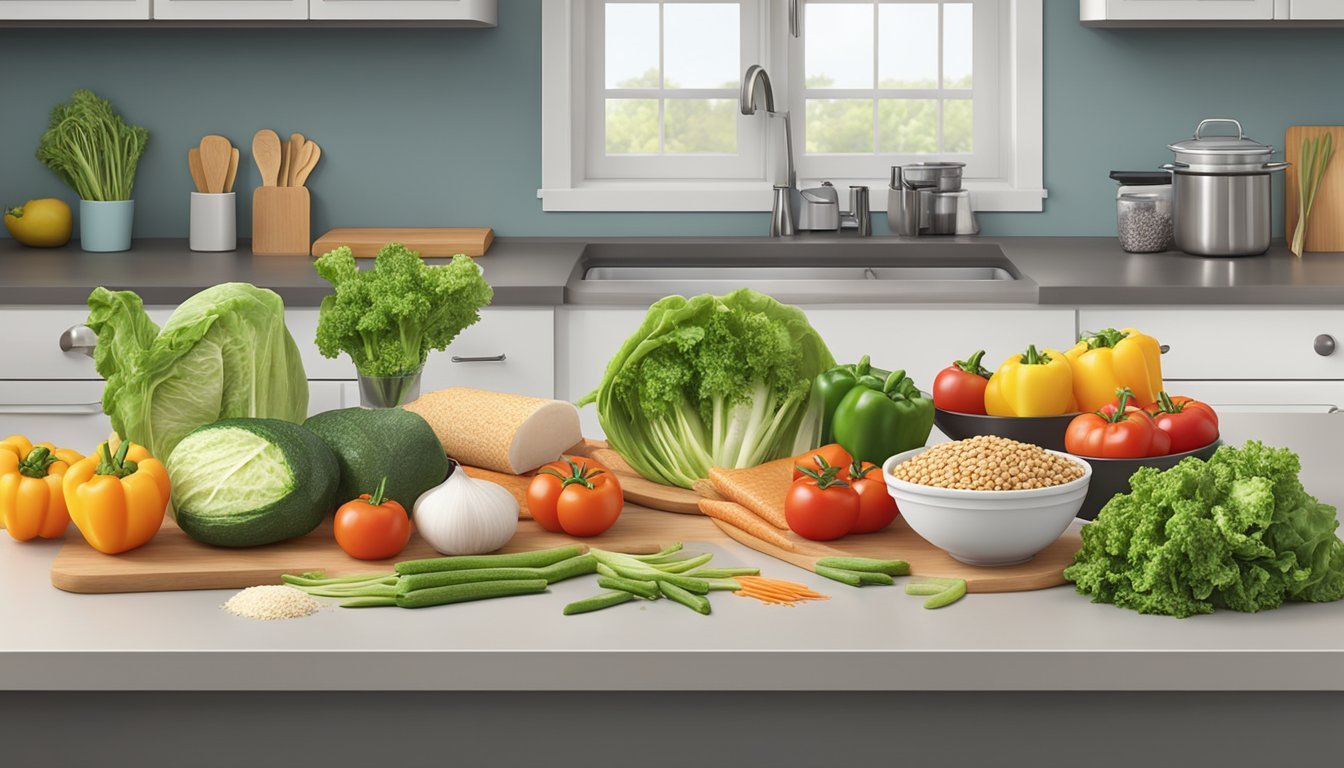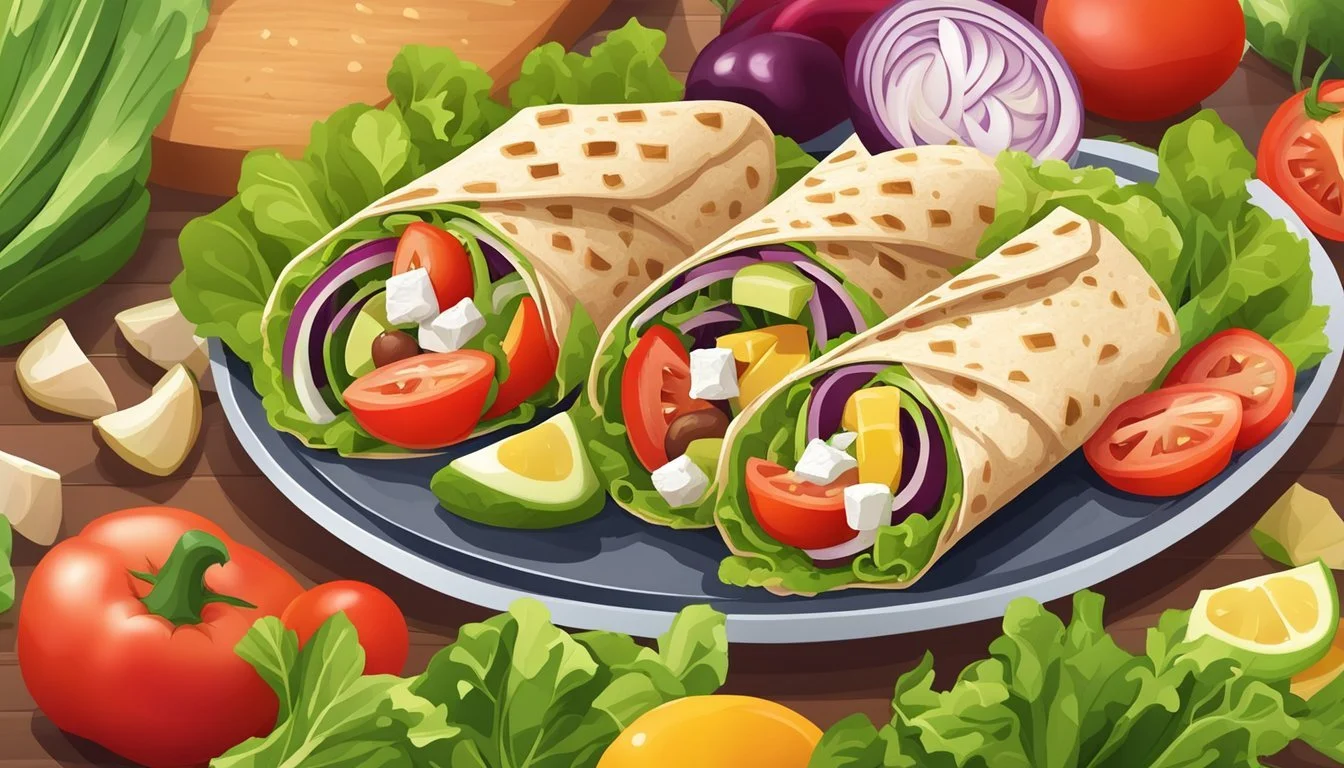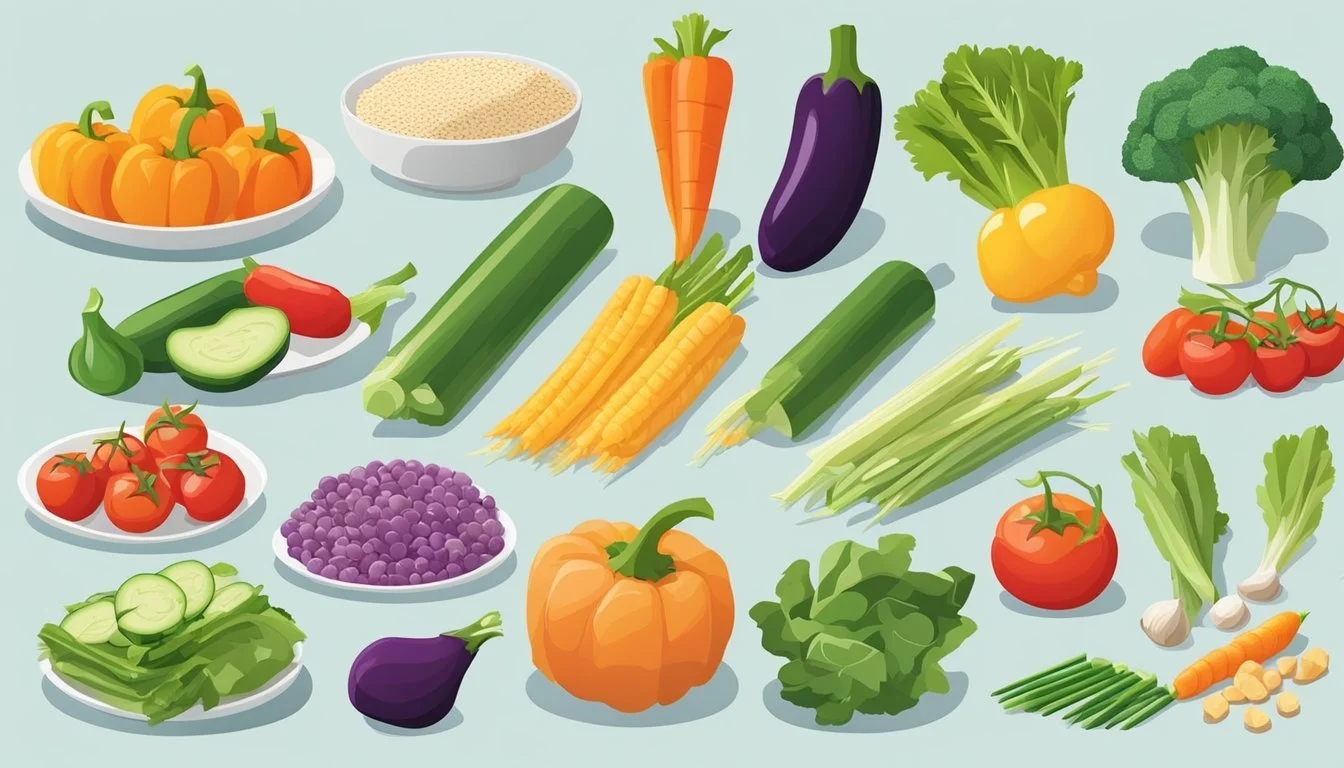6 Delicious Diabetes-Friendly Wrap Recipes for Healthy Eating
Eating well is crucial for managing diabetes, and finding meals that are both tasty and nutritious can be a challenge. Wrap recipes provide a versatile option for those looking to maintain blood sugar levels without sacrificing flavor.
This article presents six delicious diabetes-friendly wrap recipes perfect for lunch or dinner. These wraps are easy to prepare and packed with healthy ingredients that support dietary goals.
1) Grilled Chicken and Avocado Wrap
This wrap combines grilled chicken and creamy avocado, making it both nutritious and satisfying.
To prepare, heat a grill pan and cook the chicken on both sides, roughly three minutes each. Peel and slice the avocado, adding lemon juice to prevent browning.
Warm the tortilla wraps briefly to make folding easier. Spread a generous spoonful of mashed avocado mixed with Greek yogurt, cilantro, lime juice, salt, and black pepper.
Place the cooked chicken onto the tortillas, then fold the bottom up and the sides over the filling. Optionally, grill the wrapped tortillas briefly to add a bit of crunch.
This wrap is low in saturated fat and high in lean protein, making it an excellent option for those managing diabetes.
2) Greek Salad Chicken Wrap
This Greek Salad Chicken Wrap combines vibrant flavors with a diabetes-friendly profile. It's a delicious way to enjoy Mediterranean cuisine while keeping blood sugar levels in check.
Start by laying a whole grain tortilla on a flat surface. Whole grain tortillas are a healthier choice due to their lower glycemic index.
Add a generous layer of fresh greens such as romaine lettuce. Greens provide essential vitamins and add a satisfying crunch.
Layer thinly sliced cucumber, red onion, and halved grape tomatoes over the greens. These vegetables add flavor without adding unnecessary carbs.
Top the vegetables with sliced, grilled chicken breast. Chicken is a great source of lean protein, which helps in managing blood sugar levels.
For added taste, sprinkle crumbled feta cheese and a few Kalamata olives. These ingredients offer healthy fats and a depth of flavor.
Drizzle a tablespoon of tzatziki sauce over the fillings. Tzatziki adds a creamy texture and a hint of garlic without overwhelming the wrap.
Once all items are added, fold the sides of the tortilla over the fillings, then roll tightly. This ensures the wrap holds together and is easy to eat.
This Greek Salad Chicken Wrap is a nutritious option packed with flavor and diabetes-friendly ingredients. Enjoy it as a quick lunch or a light dinner.
3) Hummus and Veggie Wrap
The Hummus and Veggie Wrap offers a nutritious and flavorful meal option. This wrap is packed with a variety of fresh vegetables like tomatoes, cucumbers, and mixed greens. These vegetables provide essential vitamins and minerals, contributing to a balanced diet.
Hummus serves as the primary spread and adds a creamy texture to the wrap. This spread, made from chickpeas, is rich in protein and fiber. These nutrients help in stabilizing blood sugar levels, making it suitable for people with diabetes.
Additional flavor can be achieved by incorporating fresh herbs such as cilantro or parsley. These herbs not only enhance the taste but also offer additional health benefits. Feta cheese can also be added for an extra layer of taste and protein.
The wrap itself is typically gluten-free and low-carb, which further supports diabetes meal planning. Preparing the hummus ahead of time can make assembling this wrap quick and convenient. This makes it a practical option for a fast, healthy meal.
Overall, the Hummus and Veggie Wrap combines simplicity with nutritional benefits, making it an excellent choice for a diabetes-friendly diet.
4) Turkey and Spinach Wrap
A Turkey and Spinach Wrap offers a quick, nutritious option for those managing their carbohydrate intake. It requires simple ingredients and minimal preparation time.
Begin with a whole-wheat tortilla or low-carb wrap, which provides fiber. Spread a mixture of mayonnaise and Dijon mustard evenly over the tortilla.
Add fresh baby spinach leaves, rich in vitamins and low in carbs. Place thin slices of turkey breast on top. For added flavor and texture, include sliced avocado, ripe tomatoes, or thin apple slices.
Roll the tortilla tightly to ensure the ingredients stay inside. Cutting the wrap in half makes it easy to serve. This recipe provides a balanced mix of protein and vegetables, perfect for a diabetes-friendly meal.
5) Cilantro Lime Shrimp Wrap
Cilantro Lime Shrimp Wrap is a refreshing and flavorful option for those seeking a diabetes-friendly recipe. This wrap combines succulent shrimp with a zesty lime and cilantro marinade.
To start, marinate the shrimp in a mixture of lime juice, fresh cilantro, garlic, cumin, salt, and pepper. Allow the shrimp to marinate in the refrigerator for 15 minutes to enhance the flavors.
Next, cook the shrimp in a skillet over medium heat with a touch of olive oil. The shrimp will need about 2-4 minutes until they turn pink and opaque.
Once the shrimp are cooked, assemble the wrap by placing them on a large lettuce leaf. Add additional fresh cilantro and a squeeze of lime if desired.
This wrap delivers a delightful combination of tangy and savory notes. It’s a perfect choice for a light meal or appetizer, keeping the nutrient profile balanced and appealing for those managing their blood sugar levels.
6) Tofu and Peanut Sauce Wrap
Tofu and peanut sauce wraps offer a tasty and health-conscious meal option for individuals managing diabetes. This dish combines crispy tofu with a rich, flavorful peanut sauce, creating a satisfying wrap that is both nutritious and delicious.
Start by pressing and slicing tofu into strips or cubes. Bake or stir-fry the tofu until golden and crispy.
Prepare the peanut sauce by mixing peanut butter, soy sauce, a touch of maple syrup, and a bit of chili garlic sauce. Adjust seasoning to taste.
Lay out a whole-grain wrap. Spread a layer of the peanut sauce down the center.
Add the cooked tofu, followed by fresh vegetables like lettuce, carrots, and bell peppers. Roll up the wrap and slice it in half.
These wraps are easy to prepare and can be customized with different veggies. They make for a perfect lunch or light dinner option.
Serve with additional peanut sauce on the side for extra flavor.
This tofu and peanut sauce wrap is both diabetes-friendly and packed with protein and fiber.
Understanding Diabetes and Diet
Diet plays a crucial role in managing diabetes. It's essential to comprehend the importance of balanced nutrition and the impact carbohydrates have on blood sugar levels.
Importance of a Balanced Diet for Diabetes Management
A balanced diet helps maintain optimal blood sugar levels and overall health for individuals with diabetes. Eating various nutrient-dense foods ensures a proper intake of vitamins, minerals, fiber, and other essential nutrients.
Key components:
Proteins: Aid in muscle repair and growth.
Healthy fats: Support cell function and absorb vitamins.
Carbohydrates: Main source of energy but should be monitored.
Maintaining a balance across these nutrient categories helps prevent spikes in blood sugar levels and can support weight management. Consuming fiber-rich foods like vegetables, fruits, and whole grains can slow digestion, leading to more stable glucose levels. Limiting processed foods and sugary snacks is also beneficial for better glycemic control.
How Carbohydrates Affect Blood Sugar Levels
Carbohydrates have the most significant impact on blood sugar levels as they are broken down into glucose during digestion. Simple carbohydrates like sugar and refined grains cause rapid spikes in blood sugar, while complex carbohydrates like whole grains and legumes promote slower, more gradual increases.
Different Types of Carbs:
Simple Carbs: Found in sweets, sodas, and some fruits.
Complex Carbs: Found in whole grains, beans, and vegetables.
Monitoring the glycemic index (GI) of foods can be helpful. Foods with a low GI are less likely to cause rapid spikes, thus aiding in better blood sugar management. Portion control and meal timing are also crucial strategies in managing the effects of carbs on blood glucose. By understanding these elements, individuals can make more informed food choices and improve their diabetes management.
Healthy Ingredients for Diabetes-Friendly Wraps
Focusing on low-glycemic vegetables, the right protein sources, and whole grain or low-carb wrap options ensures wraps that are both delicious and suitable for managing diabetes.
Low-Glycemic Vegetables to Include
Incorporate vegetables that have a low glycemic index (GI). Options like spinach, kale, and arugula are excellent, providing essential nutrients without spiking blood sugar levels.
Tomatoes, cucumbers, and bell peppers are also low-GI choices. These vegetables are rich in fiber and antioxidants, promoting better overall health.
For a crunchy texture, add shredded cabbage or carrots. They add bulk to the wrap, making it more filling. Always opt for fresh, raw vegetables to maximize their nutritional value.
Choosing the Right Protein Sources
Lean proteins help in stabilizing blood sugar. Grilled chicken, turkey breast, and tofu are perfect for this purpose. They are low in fat yet high in protein, making them ideal for maintaining muscle mass and overall health.
Fish like salmon and tuna are rich in omega-3 fatty acids, which have anti-inflammatory properties. Including these in wraps can enhance both flavor and nutritional benefits.
For plant-based options, chickpeas or other legumes are great choices. They offer high fiber and protein content. Ensure proteins are cooked healthily, avoiding frying, to keep them low in unhealthy fats.
Whole Grain and Low-Carb Wrap Options
Whole grain wraps, such as whole wheat or spelt, offer more fiber and nutrients compared to refined grains. They help in maintaining steady blood sugar levels and promote digestive health.
Low-carb wraps made from almond flour, coconut flour, or flaxseeds are also excellent. They are suitable for those aiming to restrict carbohydrate intake more strictly.
Another option includes lettuce wraps, using leaves from Boston or Bibb lettuce. These are virtually carb-free, keeping the wrap light and refreshing. Whole grain and low-carb options provide variety while maintaining dietary goals.
Tips for Preparing and Storing Wraps
Preparing and storing wraps effectively can enhance both their flavor and nutritional benefits. Focus on using fresh ingredients and adopting proper storage techniques to ensure each wrap remains tasty and safe to eat.
Meal Prep Strategies for Busy Schedules
Planning and Ingredient Selection: To streamline meal prep, select ingredients that complement each other well. Opt for high-fiber wraps, lean proteins like grilled chicken or tofu, and fresh vegetables. Prep all fillings in advance by washing, chopping, and portioning them.
Assembly Line Technique: Set up an assembly line for efficient wrap preparation. Lay out all ingredients and build multiple wraps at once. This method saves time and ensures a consistent, balanced distribution of ingredients across each wrap.
Storage and Portioning: Once the wraps are assembled, individually wrap them in parchment paper or aluminum foil. This prevents them from getting soggy and makes them easy to grab-and-go. For those with tight schedules, consider freezing the wraps. Select ingredients that freeze well and thaw without losing texture.
Proper Storage Techniques to Maintain Freshness
Refrigeration Best Practices: Store prepared wraps in the refrigerator if you plan to consume them within a few days. Use air-tight containers or zip-lock bags to prevent moisture and air from degrading the ingredients. Label each pack with the date to track freshness easily.
Use of Moisture Barriers: To keep wraps from becoming soggy, layer ingredients thoughtfully. Place moisture-rich items like tomatoes or cucumbers in the center and drier ingredients, like greens or proteins, toward the edges. Wrapping in paper towels can also absorb excess moisture.
Freezing Tips: If storing wraps longer, freeze them individually. Use plastic wrap followed by a layer of freezer-safe aluminum foil. This double layer protects against freezer burn. Thaw wraps in the refrigerator overnight before consuming, and reheat in a microwave or oven if preferred.
Following these tips ensures each wrap delivers maximum flavor and nutrition, regardless of when it’s enjoyed.






